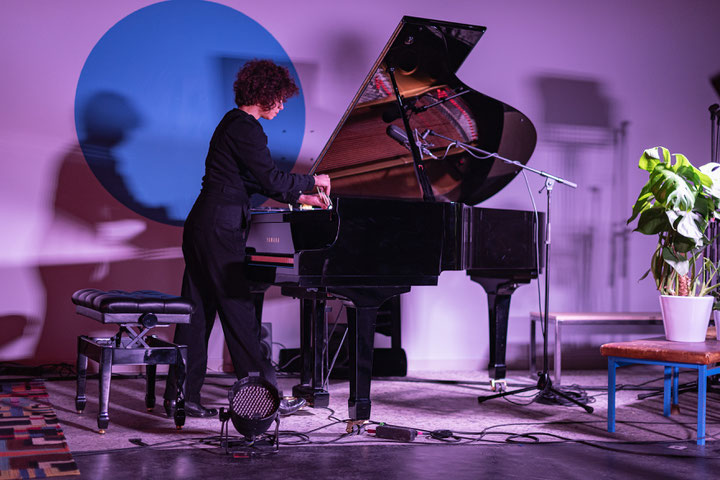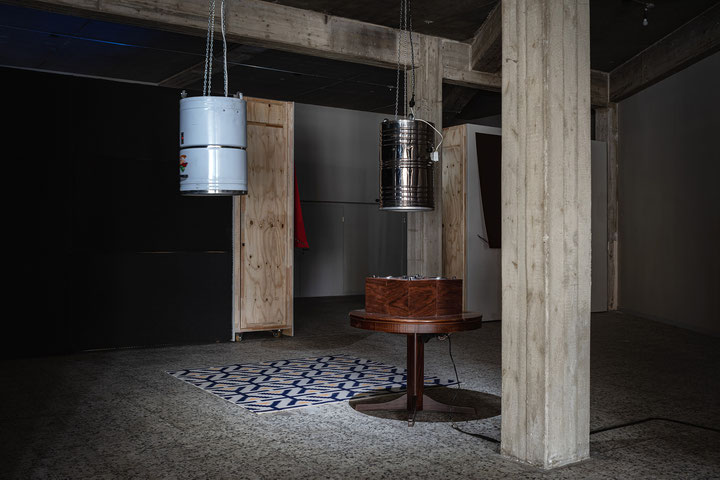Issue 2/2021 - Net section
Cosmic Vibration
SAVVY Berlin and MaerzMusik Commemorate Electronic Pioneer and Ethnomusicologist Halim El-Dabh
Perhaps it is because academic sound research and new music are fairly closed communities that Halim El-Dabh has to date been little or even entirely unknown in Europe. Yet the musician and composer, who was born in Cairo in 1921 and died in the USA in 2017, achieved legendary status during his lifetime – at least in small, rather exclusive transatlantic electronic avant-garde and ethnomusicology circles. That makes it all the more laudable that Berlin’s MaerzMusik Festival and the art space SAVVY Contemporary organised a multidisciplinary homage to El-Dabh to mark his 100th birthday – with fabulous productions that move far beyond the narrower realm of the institutional electronic music world. For the most part only accessible online, these events spanned an impressive arc that encompassed music, performance, film, installation, and other related art forms.
It all began at the Dakar Biennale 2018, for which Bonaventure Soh Bejeng Ndikung, Artistic Director of SAVVY, put together a cross-disciplinary programme in memory of Halim El-Dabh. That pioneering move presented the “sonic cosmologies”1 of the modernist globetrotter and avant-garde artist to a broader art audience for the first time – on the basis of commissioned works, some of which form the nucleus of the current Berlin show. Initially planned for 2020, the project, complemented by several new musical performances, had to be postponed until March 2021 due to the pandemic – and consequently El-Dabh’s multifaceted oeuvre, including follow-up artistic interpretations, could be explored right on time for his 100th birthday. One part of this was the MaerzMusik festival stream, which turned the supposed shortcomings of the online format into a veritable trump card.
That was vividly demonstrated for example by Mazen Kerbaj and Ute Wassermann’s 45-minute Revisitations. Taking as their point of departure El-Dabh’s composition Leiyla and the Poet for voice and electronics, recorded in 1959 at the famous Princeton Columbia Electronic Music Center in New York, the two musicians ignited a dialogue-based beacon with an arsenal of the most diverse sound generators, making the original shine in a new, sparkling sonic light. The unforeseen components that the online cinematic format can bring to light (and that are only afforded to a limited degree by in-person settings) were revealed thanks to the close links established between the cinematography and the two performers’ gestural movements.
Sofia Jernberg’s vocal bravura was a further highlight in the eight-hour opening programme, Invocations, which was broadcast alternately from SAVVY Contemporary and Haus der Berliner Festspiele: El-Dabh’s lifelong preoccupation with vibration as the core of any musical, indeed cosmic, physique was brilliantly dissected and re-assembled by Jernberg to form a tremolo soundscape that you would never have suspected could lie within the human vocal compass. Madga Mayas took a similar “friction-oriented” stance vis-à-vis conventional tonal registers in her fantastically inventive performance not on but with a specially prepared piano. In the process, she magnificently highlighted El-Dabh’s credo of “heterophony”, also described as “tonal friction”, which gives expression to higher-order harmony2. El-Dabh once described this approach as “Eastern dissonance”3 – the introduction of melodic and rhythmic dissonances, as practiced for centuries in Middle Eastern and African music, into Western harmony systems. Jessica Ekomane’s electronic composition Music Enriched by Traditions From the Depth of Time (the title refers to El-Dabh’s ethnomusical feat of founding the Orchestra Ethiopia in Addis Ababa in 1963 and specifically to a report on it that he produced for The New York Times) brought this resolutely up to date with the contemporary digital realm.4 Ekomane’s microscopic, perpetually morphing assemblage of disparate harmonic particles creates an “Eastern dissonance” that chimes with the present and underscores El-Dabh’s assertions concerning the particular sculptural quality of electronic sounds.5
The Invocations programme contained a plethora of other content – panels on specific aspects of El-Dabh’s work, performances that created a choreographed version of his compositions, and live visuals that sought to conjure up cinematic updates, especially of his electronic pieces. Here History Began. Tracing the Re/Verberations of Halim El-Dabh, the exhibition extending over two floors at SAVVY, served as a backdrop and explored the artistic resonances of this exceptional musical oeuvre. The show, curated by Kamila Metwaly, was strikingly “full-spectrum”, i.e. it encompassed almost the entire span of contemporary art. (In 2020 Metwaly had also created the audio composition A Sonic Letter to Halim El-Dabh,6 which formed the starting point for her sister Jasmina Metwaly’s film Leila and the Poet - de lalala ti-ra, which is screening as part of the MaerzMusik program).
The title Here History Began references El-Dabh’s famous commission Son et Lumière, which to this day is played for visitors to the pyramids of Giza every evening.7 Several works naturally picked up on this context, such as Theo Eshetu’s eponymous video, in which popular film images of Egypt undergo a litmus test through El Dabh’s music that picks up on Orientalism and clichéd Othering in this imagery. Magdi Mostafi’s installation Sound Cells also draws on El-Dabh’s years as a young man in Cairo by staging such unusual sound generators as washing-machine drums – E-Dabh has commented that the sound of weekly laundering of clothes was, along with Friday prayers, one of the most typical soundscapes of his birthplace. Vivian Caccuri’s installation Cyclone Aegypti, on the other hand, references early experiments by the musician, who, as a budding agricultural engineer, used metallic sounds in attempts to protect the harvest from the annual menace of insect infestations.
El-Dabh’s fundamental concept of sound as cosmic vibration – not directed against a single species, but in the broadest possible harmony with all living things, aiming for the well-being of all – figured, of course, in many of the audio works. The spectrum ranged from Satch Hoyt’s elegantly minimalist, interactive wall tableau Tape Head (eliciting unusual sounds from stretched skins by means of magnetic tape bows) to the ethnomusicological journey through Africa that Matana Roberts set to music (Laying Track).
El-Dabh’s fascination with colour music notation, which he pursued in his later years, also found a visual echo in a number of works, most remarkably in Sensing Sound Through Color, Tegene Kunbi’s oil paintings, hung as a composition. A wide variety of formats and geometric colour combinations, mostly applied impasto, cited El-Dabh’s synaesthetic credo that sonority can also be identified in spatially accentuated colour frequencies. That closes the loop to the great, universal (yet never mystical) vibration that is encapsulated in Lorenzo Sandoval and Pedro André’s hybrid-documentary film collage The Book of Vibration. Viewing friction between the most diverse spaces of reference or harmony as the epitome of life-affirming vibrancy, the exhibition (and the overall focus of MaerzMusik) more than did justice to this principle in all its aesthetic ramifications.
Selected programmes will be available for some time at https://www.berlinerfestspiele.de/de/berliner-festspiele/on-demand/2021/maerzmusik/halim-el-dabh.html or at https://www.youtube.com/watch?v=OXAEbcjt7zM&t=5s.
Info on Here History Began at https://savvy-contemporary.com/en/projects/2021/here-history-began/.
Translated by Helen Ferguson
[1] https://savvy-contemporary.com/site/assets/files/3841/barkingdog_concept.pdf
[2] Quoted from Denise A. Seachrist, The Musical World of Halim El-Dabh. Kent State University Press 2003, p. 45.
[3] The New York Times, 2nd March, 1958.
[4] Music Enriched by Traditions From the Depths of Time, in: The New York Times, 20th September 1964.
[5] See Bob Gluck’s interview with Halim El-Dabh; https://econtact.ca/15_2/gluck_el-dabh.html.
[6] https://vimeo.com/444541632
[7] Released as a record by the Egyptian Ministry of Culture in 1961.

